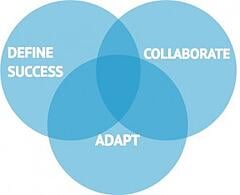Growing a school in today's innovation economy requires some strategy adjustments: Listening to families in your target market is even more important, using your school as a platform to establish trust throughout the community, and finding new ways to add value. The best schools are redefining their relationships with students and families to build proactive collaboration, enabling them to thrive within this new economic reality where trust is the valued currency.
Below are three strategies you can use to listen, build trust, and innovate.
Overtly Define Success
What would happen in your school if the board, administrators and teachers understood that they win only when the students win? Student success has to be defined so clearly that everyone at every level of leadership knows how to win. Social media and personal feedback allows you to rapidly listen and responsively improve the school's processes and results. Your reputation for excellence and trust is dominated by the voice of student and parents who will rave about your genuineness or disparage the lack of concern. As the school leader your challenge is to overtly define success so that you are truly building your school instead of that of your predecessor(s). It's hard for the other people in the school to know what you want when your directions are vague and lack purpose.
Embrace Collaboration
For a variety of reasons the culture and economy has shifted toward collaborative problem solving. School designers have to think of their students, parents, and especially teachers as interactive partners who want a real voice in decisions and plans. When they are actively encouraged to share stories, ideas, feedback, and aspirations, they become intrinsically motivated to contribute their valuable resources toward the goals of the school. This shift to collaborative design requires a more developed emotional and interpersonal intelligence among the adults involved, which also serves as a powerful model for students.
Flexibly Adapt
For the first time in the history of the world, people can learn anything without a teacher or a school. Once you get your head around that idea, it makes more sense that the school model as you know it is changing. As a school designer your organization is more likely to grow as you implement processes and systems to adapt more quickly to the needs and opportunities of your target community. Find unique ways to differentiate your program in terms of personalization, depth of experience, and autonomy over how time is used. It is likely that your school will have to find a balance between being a learning destination (comprehensive curriculum that is self-contained) and a learning portal (providing access to both local and wired learning resources with credit given based on demonstrated mastery).
The school board and administration must be prepared to manage conflict and fear as the school/district responsibly and intelligently experiments with new school designs. Obviously expectations will remain high for results, and performance assessments will need to be carefully prepared in order to communicate accurately. Common language will be key to overcoming the risks, especially in an over-politicized environment where the adult issues are prioritized over the needs of students. Dialogue and discussion will be critical to building momentum, with focus on the guiding principles rather than polarizing positions that emphasize "right" and "wrong."


